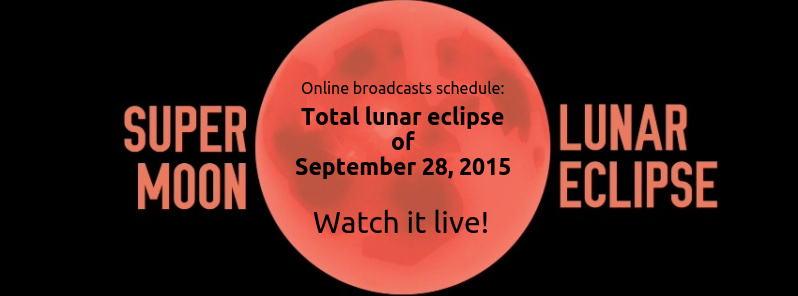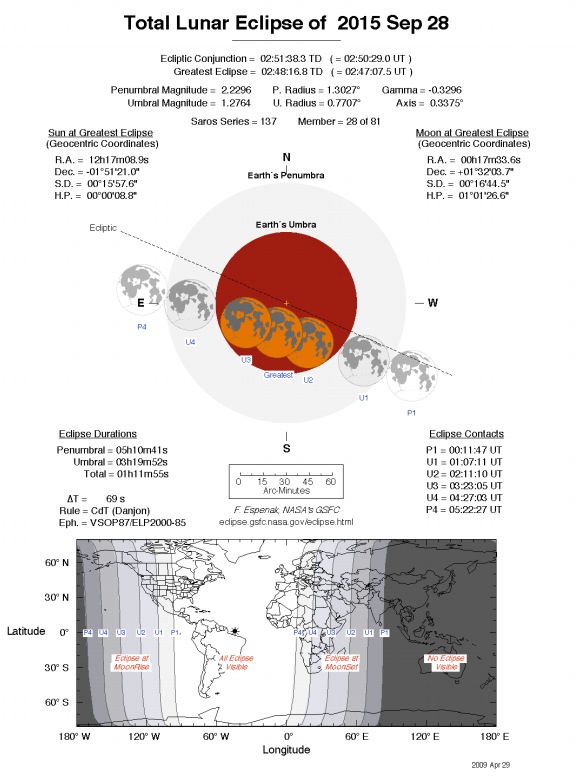Total lunar eclipse of September 28, 2015 – online broadcasts schedule

After more than 30 years a supermoon in combination with a lunar eclipse will be visible again across the skies of North and South America, Europe, Africa and parts of west Asia and the eastern Pacific. This rare celestial event is set for September 28 (UTC), 2015, and is expected to last for 1 hour and 11 minutes.
For those who might find themselves to be unlucky with their location, weather conditions or light-polluted night skies, there is still hope, as many observatories will broadcast the event – live and free:
- NASA will broadcast the event from 00:00 UTC until at least 03:30 UTC, September 28, from Marshall Space Flight Center in Huntsville with a live feed from the Griffith Observatory, Los Angeles, Adler Planetarium, Chicago, Fernbank Observatory in Atlanta and other locations across the US.
- Slooh Community Observatory will broadcast the event starting 00:00 UTC on September 28 with a live feed from Canary Islands, Spain.
- The Virtual Telescope is scheduled to stream on September 28, at 01:00 UTC with astronomical CCD image coming live from the telescope.
- Sky & Telescope's high-definition webcast will start at 01:00 UTC and will last until 04:30 UTC. Their webcast will provide uninterrupted video of the eclipse. Audio commentary will include discussions with several lunar experts.
- LA's Griffith Observatory will also host their full live coverage of the event. Live-stream broadcast will start at 01:30 UTC.
- Columbus State University – Coca-Cola Space Science Center – 2015 lunar eclipse webcast starts 23:45 UTC on September 27.

Video credit: ScienceAtNASA
The moon and its phases have been important to the human civilization throughout its history. Lunar eclipses, earlier viewed not only with awe, but also with fear, are now known to happen because the full moon passes through the darkest part of Earth's shadow, the so-called umbra.
The moon is not a source of light on its own, but is visible to us because it reflects the light coming from the sun. Its brightness decreases during a lunar eclipse, as the sunlight is blocked by Earth's shadow. During the eclipse the sunlight is refracted around the "edges" of Earth, through planets's atmosphere. When this happens, all the colors apart from red are filtered out, and the moon appears reddish or dark brown.


Image credit: Fred Espenak / NASA
Supermoon total eclipse on September 28 (UTC) will last for 1 hour and 11 minutes, and will be visible across North and South America, Europe, Africa, parts of west Asia and the eastern Pacific.
The moon will enter Earth's umbral shadow on September 28, 1:07 UTC. It will be entirely in the Earth's shadow 64 minutes later, and remain hidden for 72 minutes in total. The lunar eclipse will be visible in the night sky for the residents of North and South America, while the ones in Europe and Africa will be able to view it in the early morning sky of September 28 (UTC).
According to NASA's eclipse specialist Fred Espenak, the instant of greatest eclipse will take place at 02:47 UTC.
In the US, this is 22:47 EDT, 21:47 CDT, 19:47 PDT on September 27. In Europe, Middle East, Asia and Australia: 03:47 BST, 04:47 CET, 05:47 AST, 09:47 ICT, 12:47 AEST… on September 28.
This event is special in several ways. It is the closest full moon since March 2011, and it's the closest full moon we'll see this year, as it will be located at just 356 876 km away from Earth. The supermoon eclipse is also the final total lunar eclipse in a string of four, the so-called tetrad.
So, skywatchers across the globe, put your viewing glasses on and enjoy the cosmic spectacle!
If you miss this event, you’ll have to wait for a while, as the next supermoon eclipse won't happen again before 2033!
Featured image credit: ScienceAtNASA. Edit: TW.

Commenting rules and guidelines
We value the thoughts and opinions of our readers and welcome healthy discussions on our website. In order to maintain a respectful and positive community, we ask that all commenters follow these rules:
We reserve the right to remove any comments that violate these rules. By commenting on our website, you agree to abide by these guidelines. Thank you for helping to create a positive and welcoming environment for all.